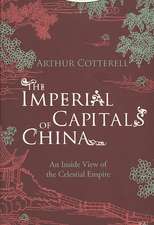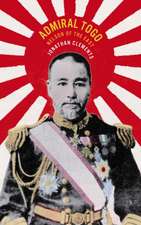A History of Korea – From "Land of the Morning Calm" to States in Conflict
Autor Jinwung Kimen Limba Engleză Hardback – 4 noi 2012
Preț: 375.36 lei
Nou
Puncte Express: 563
Preț estimativ în valută:
71.83€ • 76.81$ • 59.89£
71.83€ • 76.81$ • 59.89£
Carte disponibilă
Livrare economică 27 martie-10 aprilie
Preluare comenzi: 021 569.72.76
Specificații
ISBN-13: 9780253000248
ISBN-10: 0253000246
Pagini: 720
Ilustrații: 9 b&w illustrations, 8 maps
Dimensiuni: 162 x 235 x 46 mm
Greutate: 1.11 kg
Editura: MH – Indiana University Press
ISBN-10: 0253000246
Pagini: 720
Ilustrații: 9 b&w illustrations, 8 maps
Dimensiuni: 162 x 235 x 46 mm
Greutate: 1.11 kg
Editura: MH – Indiana University Press
Cuprins
IntroductionI. Dawn of the Korean Nation 1. The Prehistoric Age; 2. The Origins of the Korean People; 3. Old Chosun; 4. Confederated KingdomsII. The Period of the Three Kingdoms (57 BCE - 676 CE) 5. The Growth of Koguryu; 6. The Rise and Decline of Paekche; 7. The Rise and Growth of Silla; 8. The Rise and Fall of Kaya; 9. Silla's Unification; 10. Political and Social Structure of the Three Kingdoms; 11. Culture of the Three Kingdoms; 12. The Three Kingdoms and Japan; 13. "History War" with ChinaIII. Parhae, Unified Silla, and the Later Three Kingdoms (676 - 936) 14. Parhae's Rise and Growth; 15. Government and Society of Unified Silla; 16. Flourishing Culture of Unified Silla; 17. The Later Three KingdomsIV. The First Half of the Koryu Period (918 --1170) 18. Forging a Centralized Government; 19. Ruling Structure; 20. Economic and Social Structure; 21. Foreign Relations in the Early Koryu Period; 22. Development of Aristocratic CultureV. The Second Half of the Koryu Period (1170 - 1392) 23. Disturbing Koryu Society; 24. Koryu and the Mongols; 25. The Downfall of KoryuVI. The First Half of the Chosun Period (1392 - 1650) 26. Establishment of a New Order; 27. Reorganization of the Ruling Structure; 28. Social Structure and Economic Life; 29. Territorial Expansion and Foreign Relations; 30. Culture in Early Chosun; 31. The Growth of the Neo-Confucian Literati; 32. The Struggle with the Japanese and ManchusVII. The Second Half of the Chosun Period (1650 - 1910) 33. The Revival of the Dynasty; 34. The Rehabilitation of Culture; 35. The Dynasty in Disturbance; 36. Culture in the 19th Century; 37. Politics of the Taewun'gun; 38. The Open Door Policy and the Reform Movement; 39. The Tonghak Peasant War and the Kabo Reform; 40. Japanese Aggression and the Downfall of ChosunVIII. The Period of Japanese Colonial Rule (1910 - 1945) 41. Government by Bayonet and the March First Movement; 42. Japan's Shift to the "Cultural Policy" and Korean Nationalism; 43. Japan's Tightening Grip on Korea and Korean Nationalism; 44. Japan's Historical Distortions; 45. Wartime Policy of the Allied Powers on KoreaIX. Liberation, Division, and War (1945 - 1953) 46. From Occupation to a Separate Government in South Korea; 47. Economic and Social Problems in South Korea; 48. North Korea after Liberation; 49. The Two Koreas before the Korean War; 50. The Korean WarX. The Period of Postwar Reconstruction (1953 - 1971) 51. The Establishment of Authoritarian Rule in South Korea; 52. South Korean Economy and Society; 53. South Korea's Relations with the United States and Japan; 54. The Rise of the Juche (Chuch'e) State in North Korea; 55. The North Korean Economy; 56. North Korea's Foreign RelationsXI. Reversal of Fortune (1972 - 1992) 57. From Autocratic Rule to Democracy in South Korea; 58. The Prospering South Korean Economy; 59. Militaristic South Korean Society; 60. South Korea's Foreign Relations; 61. The Totalitarian State in North Korea; 62. The North Korean Economy; 63. North Korea's Foreign Relations; 64. North-South Korean RelationsXII. Both Koreas in a New Phase (1993 - the Present) 65. South Korean Democracy in Full Bloom; 66. South Korean Economy and Society; 67. The Faltering Juche State in North Korea; 68. North Korea's WMD Program; 69. North-South Korean Relations; 70. Shaking the ROK-U.S. Alliance; 71. South Korea's Relations with Neighboring Countries; 72. The Prospects for ReunificationTimeline of Korean History; Select Bibliography; Index
Recenzii
"Using the latest sources, including recently declassified Communist documents, Jinwung Kim's book holds promise of becoming the textbook of choice. Benefiting from his direct and intimate knowledge of the country, he writes with great clarity, providing rich and interesting descriptions of political, social, cultural, economic, and diplomatic developments throughout the history of Korea." James I. Mattray, California State University, Chico
Notă biografică
Descriere
A masterful account of the complex history of Korea














